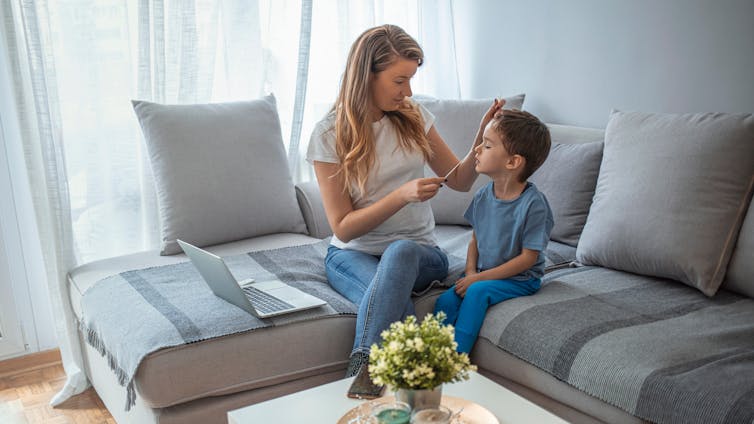Thankfully, the UK now looks to be past the peak of both the recent heatwave and the latest COVID wave. But there will be more of both – and in future, we might think about how we protect ourselves from COVID in the same way we protect ourselves from the weather.
An umbrella is a useful analogy. If we look out the window or check the weather forecast and see rain, we would probably take an umbrella out with us. Similarly, if COVID cases are starting to rise or if a new wave is forecast, we might consider grabbing a face mask, for example.
But just as there’s no need to carry an umbrella with us when it’s sunny, we needn’t be expected to wear masks all the time. Of course, some people may choose to wear masks more consistently in certain settings, while others may forgo wearing them altogether. This is the nature of the current phase of the pandemic we’re in, a big part of which is based on personal choice and responsibility.
Thanks largely to the impact of vaccines, we no longer need the kind of rules-based approach to risk management we saw earlier in the pandemic. But the umbrella analogy can guide our behaviour and choices in a variety of areas of our response moving forward. Beyond masks, these include testing, ventilation and social distancing.
The idea is that we can pick up or step up precautions when we most need them (when COVID cases are on the rise), before relaxing them, if we want to, when infection rates and risk are lower.
What might this look like in practice?
Let’s say we start to see COVID cases rising again come autumn. This is a distinct possibility.
It then becomes even more important to take a test if we have any symptoms that might be COVID-related. This will help inform our decision of whether, and to what extent, to minimise contact with others.
Isolation is no longer a legal requirement, and I think this should remain the case. However, if possible, staying at home while we’re unwell is a sensible and considerate thing to do, particularly when COVID rates are high.
Distancing should also remain a choice. But during a wave of infections, people might wish to maintain more distance between themselves and others in shops, or may choose to avoid crowded venues.
Read more:
I have COVID symptoms. Should I do a test?
Back on masks, when cases begin to rise, the risk of contracting and transmitting COVID also rises, so masks become a more useful and reasonable precaution. They can be particularly valuable in certain circumstances – for example, if someone is unwell but can’t isolate, when visiting people who are vulnerable, or in crowded indoor spaces.
Opening windows even a little can increase fresh air indoors and also help reduce the likelihood of transmitting the virus.
Finally, the number of people in the UK who have had a COVID booster vaccine is considerably lower than the number who received their first and second doses. We know immunity from vaccines wanes, and boosters restore vaccine effectiveness. So if we start to see rising cases, or looking ahead to future waves, it would make good sense for people who are behind on their vaccines to get up-to-date.

Dragana Gordic/Shutterstock
Shared responsibility
It’s been a year since England’s “freedom day”, when most legal COVID measures were removed. But the pandemic is far from over. Along with high numbers of daily infections, long COVID is very common, and the pressure on the NHS is still unsustainable.
In a recent article in the British Medical Journal, Professor Susan Michie and I reflected on some of the lessons we’ve learned over the past year.
Among these, the pandemic has shown us that behaviour is not purely down to an individual’s choice or motivation. People’s actions are also shaped by the opportunities and supports they’re given – or not given. For example, while some people might want to stay home if they have symptoms, they may not if neither their employer or the government provides financial support.
People should be encouraged and supported as much as possible to stay home when they’re sick, particularly when cases are high. Amidst a winter COVID wave, Australia has re-instated its pandemic leave disaster payments to enable those with COVID and without proper sick pay to stay home and not lose out financially.
Further, governments could ensure that free at-home tests are available during times when infections are likely to, or starting to, rise.
And it’s important that, to mitigate the impacts of future waves, vaccination coverage is as high as possible. Public health campaigns should target both the unvaccinated and partially vaccinated, as well as encouraging people (particularly the most vulnerable) to take up booster offers.
We also need more action to ensure adequate ventilation. In the US, billions of dollars are being made available for improving air quality in schools and other public buildings.
Read more:
Caught COVID? Here’s what you should and shouldn’t do when self-isolation isn’t mandatory
I’ve previously argued that the UK government puts too much responsibility in the hands of the public. Just like climate change, pandemics are global problems, and addressing them requires a collective effort.
![]()
Simon Nicholas Williams has received funding from Swansea University, the University of Manchester, Senedd Cymru and Public Health Wales for research on COVID-19. However, this article reflects the views of the author only and no funding bodies were involved in the writing or content of this article.









